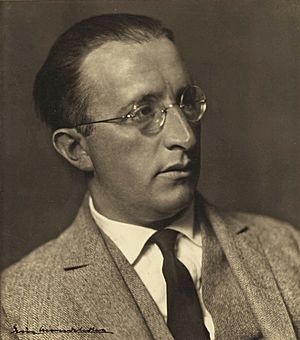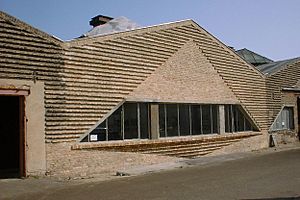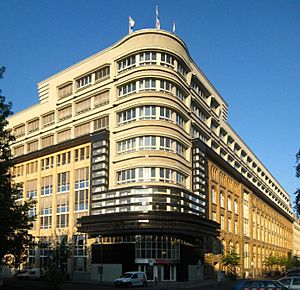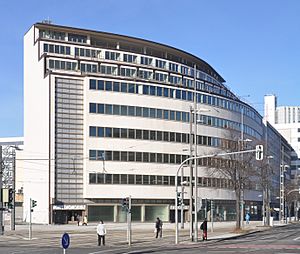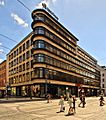Erich Mendelsohn facts for kids
Erich Mendelsohn (born March 21, 1887 – died September 15, 1953) was a famous Jewish German architect. He was known for his unique expressionist architecture in the 1920s. He also created a new style of functionalism for buildings like department stores and movie theaters.
Mendelsohn helped start the Art Deco and Streamline Moderne styles of architecture. His 1921 design for the Mossehaus building is a great example of his work.
Contents
About Erich Mendelsohn
Erich Mendelsohn was born in Allenstein, which was then in East Prussia, Germany. Today, this town is called Olsztyn and is in Poland. His birthplace is now marked with a special plaque on a wall.
He was the fifth of six children. His mother, Emma Esther, made hats, and his father, David, was a shopkeeper. Erich went to a good school in Allenstein. Later, he studied business in Berlin.
In 1906, he began studying economics at the University of Munich. In 1908, he started studying architecture at the Technical University of Berlin. Two years later, he moved to the Technical University of Munich, where he graduated with honors in 1912. In Munich, he learned from architect Theodor Fischer. Mendelsohn also met artists from groups like Der Blaue Reiter and Die Brücke, who were known for their expressionist art.
From 1912 to 1914, he worked as an architect on his own in Munich.
In 1915, he married Luise Maas, who played the cello. They wrote many letters to each other from 1910 to 1953. These letters show what life was like for them as the world changed, especially when they had to leave Germany in 1933. Through his wife, he met Erwin Finlay Freundlich, an astrophysicist who also played the cello.
Freundlich wanted to build a special observatory to test Einstein's Theory of Relativity. This led Mendelsohn to design the famous Einsteinturm ("Einstein Tower"). This project, along with his work for the Herrmann hat factory in Luckenwalde, helped him become successful early in his career.
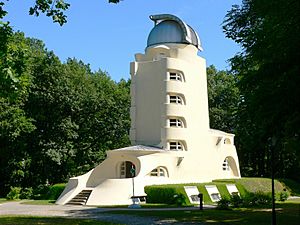
His Architecture Career
After World War I ended in 1918, Erich Mendelsohn set up his architecture office in Berlin. The Einstein Tower and the hat factory in Luckenwalde made him very well-known. The Hat Factory was designed in 1921. Mendelsohn's plan included production halls, a boiler house, and a special dyeing hall. The dyeing hall had a modern, hat-shaped roof that helped remove toxic fumes.
By 1924, a magazine about architecture featured his work. In the same year, he helped start a group of modern architects called Der Ring, along with Ludwig Mies van der Rohe and Walter Gropius.
His office grew to have about forty employees. Mendelsohn's designs often showed the new consumer culture of Germany at the time, especially his designs for department stores like the famous Schocken Department Stores. He also designed the Red Banner Textile Factory in the USSR in 1926. His Mossehaus newspaper offices and Universum cinema were also very important for the Art Deco and Streamline Moderne styles.
In 1926, he bought an old house. In 1928, he designed a large new home for his family called Rupenhorn. This house was nearly 4,000 square meters.

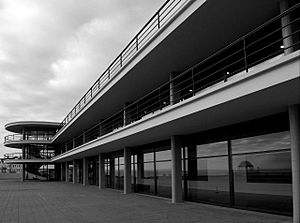
In the spring of 1933, Mendelsohn had to leave Germany because of difficult political times and growing prejudice against Jewish people. He moved to England. The Nazis took his property, and he was removed from German architect groups. In England, he started an architecture firm with Serge Chermayeff. They designed important buildings like the De La Warr Pavilion, a large entertainment and arts center in Bexhill-on-Sea.
Mendelsohn knew Chaim Weizmann, who later became the first President of Israel. In 1934, Mendelsohn began planning several projects in Palestine (which is now Israel) for Weizmann. In 1935, he opened an office in Jerusalem. He designed buildings there using the International Style, which greatly influenced local architecture.
In 1938, he closed his London office. He and his wife became British citizens, and he changed his first name to "Eric." This new citizenship also helped them bring other family members to Britain. In Palestine, Mendelsohn built many famous buildings, including the Weizmann House, laboratories at the Weizmann Institute of Science, the Anglo-Palestine Bank in Jerusalem, and hospitals like Hadassah Hospital on Mount Scopus and Rambam Hospital in Haifa.
From 1941 until he died, Mendelsohn lived in the United States. He taught at the University of California, Berkeley. During World War II, he mostly gave lectures and wrote. He also advised the U.S. government. For example, in 1943, he helped the U.S. Army and Standard Oil build "German Village." This was a set of fake German houses used to learn how to bomb German cities effectively. In 1945, he settled in San Francisco. From then until his death in 1953, he worked on many projects, mostly for Jewish communities.
Selected Buildings by Erich Mendelsohn
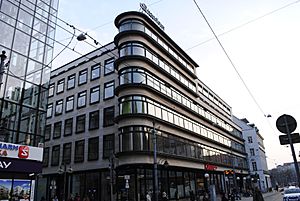
- Taharah building in Allenstein (1913), now called the Mendelsohn house.
- Work hall of the Herrmann hat factory, Luckenwalde (1919-1920).
- Einsteinturm (solar observatory) in Potsdam (1920-1921). This tower looks like it's made of concrete, but it's mostly brick.
- Steinberg hat factory, Luckenwalde (1921-1923), known for its sharp, angular shape.
- Mossehaus, offices for Rudolf Mosse, Berlin (1921-1923).
- Schocken department store, Nuremberg (1925-1926).
- Red Flag Textile Factory, Leningrad (1926). Mendelsohn designed the power station part of this factory.
- Extension of Cohen & Epstein department store, Duisburg (1925-1927).
- Schocken department store, Stuttgart (1926-1928). This building was later torn down in 1960, despite protests.
- Exhibition pavilion for Rudolf Mosse at the Pressa fair in Cologne (1928).
- Woga-Komplex and Universum-Kino (cinema), Berlin (1925-1931).
- Schocken department store, Chemnitz (1927-1930), famous for its curved front with horizontal windows.
- His own home, Am Rupenhorn, Berlin (1928-1930).
- Columbushaus, Potsdamer Platz, Berlin (1928-1932). This building was destroyed in 1957.
- Bachner department store in Ostrava (1932-1933).
- Jewish youth center, Essen (1930-1933).
- Nimmo House (later Shrubs Wood), Chalfont St Giles, England (1933–1934). Designed with Serge Chermayeff.
- The De La Warr Pavilion, Bexhill-on-Sea, England (1934). Designed with Serge Chermayeff.
- Cohen House, Chelsea, London (1934-1936). Designed with Serge Chermayeff.
- Weizmann House, Weizmann Institute campus, Rehovot (1935-1936).
- Three buildings on the Weizmann Institute campus for science research.
- Hebrew University, Jerusalem (1934-1940).
- Synagogue B'Nai Amoona, now Center of Creative Arts, University City, Missouri (1946-1950).
- Maimonides Hospital, San Francisco (1946-1950).
- Park Synagogue, Cleveland Heights, Ohio (1947-1951).
- Beth El Synagogue, Baltimore, Maryland (1948).
- Russell House, San Francisco, California (1951).
Images for kids
-
Petersdorff department store in Wrocław
See also
 In Spanish: Erich Mendelsohn para niños
In Spanish: Erich Mendelsohn para niños


